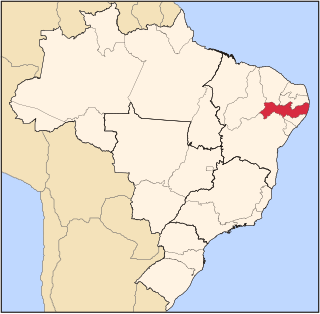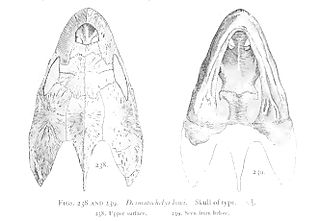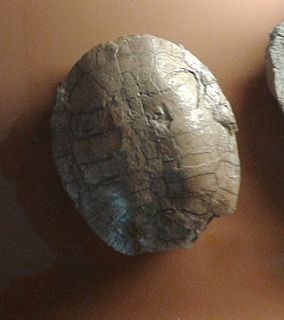
Paulista is a municipality in Pernambuco, Brazil, with a population of 334,376 as of 2020. It has the highest Human Development Index (HDI) of the Recife metropolitan area. It is the birthplace of footballer Rivaldo and is also famous for its beaches, including Maria Farinha with the giant Veneza water park. It was incorporated as a city in 1935.

Podocnemididae is a family of pleurodire (side-necked) turtles, once widely distributed. Most of its 20 genera and 30 species are now extinct. Seven of its eight surviving species are native to South America: the genus Peltocephalus, with only one species ; and the genus Podocnemis, with six living species of South American side-necked river turtles. There is also one genus native to Madagascar: Erymnochelys, the Madagascan big-headed turtle, whose single species E. madagascariensis.

Unaysaurus is a genus of unaysaurid sauropodomorph herbivore dinosaur. Discovered in southern Brazil, in the geopark of Paleorrota, in 1998, and announced in a press conference on Thursday, December 3, 2004, it is one of the oldest dinosaurs known. It is closely related to plateosaurid dinosaurs found in Germany, which indicates that it was relatively easy for species to spread across the giant landmass of the time, the supercontinent of Pangaea.

Bothremydidae is an extinct family of side-necked turtles (Pleurodira) known from the Cretaceous and Cenozoic. They are closely related to Podocnemididae, and are amongst the most widely distributed pleurodire groups, with their fossils having been found in Africa, India, the Middle East, Europe, North America and South America. Bothremydids were aquatic turtles with a high morphological diversity, indicative of generalist, molluscivorous, and piscivorous diets. Unlike modern pleurodires, which are exclusively freshwater, bothremydids inhabited freshwater, marine and coastal settings. Their marine habits allowed bothremydids to disperse across oceanic barriers into Europe and North America during the early Late Cretaceous (Cenomanian). The youngest records of the group are indeterminate remains from Saudi Arabia and Oman, dating to the Miocene.

Guarinisuchus is an extinct genus of marine crocodyliform from the Early Paleocene 62 million years ago of the Maria Farinha Formation, Brazil. The type species is G. munizi. It was a dominant predator in its environment, and probably reached a length of 3 metres (9.8 ft). Guarinisuchus appears to be closely related to marine crocodylomorphs found in Africa, which supports the hypothesis that the group originated in Africa and migrated to South America before spreading into the waters off the North American coast.

Desmatochelys is an extinct genus of sea turtles belonging to the family Protostegidae. This genus contains two known species, D. lowii and D. padillai. D. lowii was first discovered in 1895, followed by D. padillai in 2015. Having been estimated at over 120 million years old, D. padillai is currently the oldest known species of sea turtle.
Terlinguachelys fischbecki is an extinct sea turtle that existed during the Late Cretaceous period some 80 million years ago. It is the sole species in the genus Terlinguachelys and is classified in the family Protostegidae along with other extinct marine turtles.
Caririemys is an extinct genus of side-necked turtles, belonging to the Pelomedusoides of the family Euraxemydidae. The type species is C. violetae. A single fossil of an individual was found in the Santana Formation in Brazil, an 80-million-year-old Late Cretaceous deposit that has so far preserved other fossil reptiles such as dinosaurs and crocodilians.

Cearachelys is an extinct genus of pleurodiran turtle which existed some 110 million years ago. The genus is monotypic, with only type species Cearachelys placidoi known.
The Tiupampan age is a period of geologic time within the Paleocene epoch of the Paleogene used more specifically with South American land mammal ages (SALMA). It is the oldest SALMA age and precedes the Peligran age.
The Santa Lucía Formation is a Maastrichtian to Paleocene (Danian) geologic formation in Bolivia. Fossil ornithopod tracks have been reported from the Cretaceous lower part of the formation. It is the type formation of the Tiupampan South American land mammal age.

Leyvachelys is an extinct genus of turtles in the family Sandownidae from the Early Cretaceous of the present-day Altiplano Cundiboyacense, Eastern Ranges, Colombian Andes. The genus is known only from its type species, Leyvachelys cipadi, described in 2015 by Colombian paleontologist Edwin Cadena. Fossils of Leyvachelys have been found in the fossiliferous Paja Formation, close to Villa de Leyva, Boyacá, after which the genus is named. The holotype specimen is the oldest and most complete sandownid turtle found to date.
The Guabirotuba Formation is a late Middle Eocene geologic formation of the Curitiba Basin in Paraná, Brazil. The formation crops out in and around the city of Curitiba and comprises mudstones and sandstones deposited in a fluvial floodplain environment.
The Maria Farinha Formation is a geological formation of the Parnaíba Basin in Pernambuco, northeastern Brazil whose strata date back to the Danian stage of the Paleocene, or Tiupampan in the SALMA classification.
Itapecuruemys is an extinct genus of bothremydid pleurodiran turtle that was discovered in the Itapecuru Formation of Brazil. It is a monotypic genus, with only type species Itapecuruemys amazoniensis known.
Ilatardia is an extinct genus of bothremydid pleurodiran turtle that was discovered in the Farin Doutchi Formation of Niger. The genus consists solely of type species I. cetiotesta.
Arenila is an extinct genus of bothremydid pleurodiran turtle that was discovered in the Western Desert of Egypt. The genus consists solely of type species A. krebsi.
Azabbaremys is an extinct genus of bothremydid pleurodiran turtle that was discovered in the Teberemt Formation of Mali. The genus consists solely of the type species Azabbaremys moragjonesi.
Eotaphrosphys is an extinct genus of bothremydid pleurodiran turtle that was discovered in the Mont Aime Formation, France. Originally assigned to the genus "Tretosternum", it consists exclusively of type species E. ambiguum.

Sahonachelys is an extinct genus of pelomedusoid turtle from the Late Cretaceous (Maastrichtian) Maevarano Formation of Madagascar. The genus contains a single species, Sahonachelys mailakavava.








